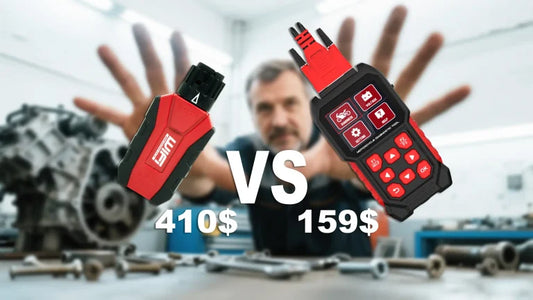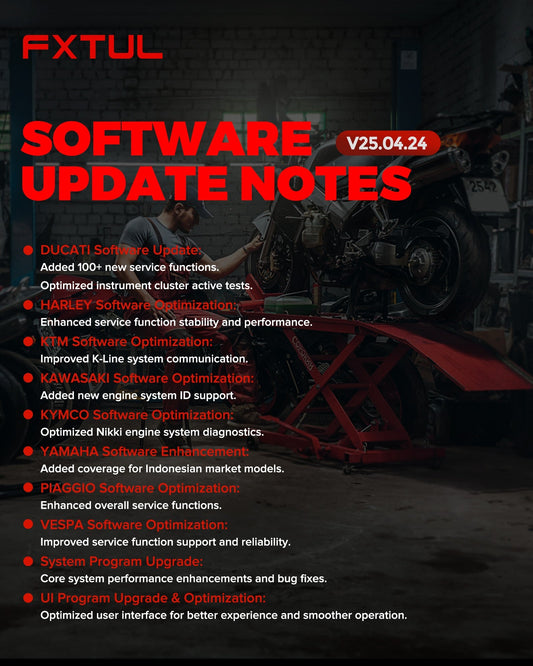Motorcycle ABS (Anti-lock Braking System) bleeding is performed to remove air from the system, ensuring the brake system works properly. When air enters the ABS system, it can affect braking performance and even cause brake failure. Therefore, the bleeding procedure is necessary.
What is ABS? How Does it Work?
What is ABS Braking?
Motorcycles are inherently less stable than four-wheeled vehicles. ABS helps prevent the wheels from locking up during braking, thereby improving the motorcycle's stability and safety. Overly aggressive braking can cause the wheels to lock up, since motorcycles are less stable, either the front or rear wheel could lock. This can lead to skidding or even tipping over. The Anti-lock Braking System can prevent the wheels from locking up up to 10 times per second, ensuring that your vehicle is always protected.
How Does ABS Work?
The operation of an ABS is as follows: On a motorcycle, both wheels are equipped with magnetic sensors that monitor the speed of the wheels. These sensors are paired with a metal toothed ring (called a tone ring or encoder ring), which generates an electrical signal.
Why is ABS Bleeding Necessary?
Impact on Braking Performance:
Air is compressible, and during braking, air can be compressed, preventing the brake fluid from effectively transmitting braking force. This reduces braking efficiency and increases stopping distance.
Possible Brake Failure:
In extreme cases, excessive air in the system can lead to complete brake failure, preventing braking altogether and creating a serious safety hazard.
Impact on ABS System Operation:
The ABS system relies on brake fluid to transmit signals that control the brakes. The presence of air can interfere with the proper functioning of the ABS, preventing it from effectively preventing wheel lock-up.
Steps for Motorcycle ABS Bleeding
If you've performed any of the following operations, ABS bleeding is necessary:
- Replacing the brake fluid.
- Replacing or disassembling the ABS module.
- Replacing or draining the master cylinder or calipers.
- The brake system ran dry (reservoir empty).
- The brake pedal or lever feels soft, or the braking performance has decreased.
|
Tools |
Descriptions |
|
Diagnostic Tool (with ABS Functionality) |
Supports ABS control module activation and the bleeding process, e.g., FXTUL M7. |
|
Brake Fluid (DOT4 / DOT5.1) |
Select according to the motorcycle manufacturer's specifications. |
|
Bleeding Bottle or Clear Hose |
Used to collect used brake fluid and observe air bubbles. |
|
Open-End Wrenches (8mm, 10mm commonly used) |
Used to open the bleeding screw. |
|
Assistant (Optional) |
Assists in operating the brake lever or pedal. |
Motorcycle ABS Bleeding Steps
Step 1: Check Fluid Level & Initial Bleeding
- Open the master cylinder cap (next to the handlebar/foot pedal) and add new brake fluid until it reaches the MAX level.
- Use traditional methods (assistance or vacuum pump method) to perform initial bleeding on the front and rear wheels, aiming to remove large air bubbles.
Step 2: Connect the Diagnostic Tool and Identify the Vehicle
- Use the OBD adapter cable (such as a motorcycle-specific 6/8-pin adapter) to connect to the diagnostic interface.
- Turn on the device, then select Brand > Model > ABS System > Bleeding/Fluid Replacement Mode.
Step 3: Enter ABS Bleeding Mode
- Start the ABS bleeding program on the diagnostic tool. The device will usually prompt you with the following steps:
◦ Continue pressing the brake lever/pedal.
◦ Open the bleeding screw.
◦ Activate the ABS pump to circulate for a few seconds.
◦ Close the bleeding screw.
◦ Repeat several times until no air bubbles appear.
Step 4: Observe the Bleeding Process
- Each time the pump starts, you may hear a "clicking" or "buzzing" sound, which indicates the electromagnetic valve or pump is operating.
- Observe the clear hose for any large air bubbles being expelled.
- Once completed, close the bleeding screw.
Step 5: Repeat for the Other Brake Circuit
- Motorcycles typically have separate front and rear brake circuits, and each must be bled independently.
- The ABS module of some models only controls the rear wheels, which also depends on the structure of the model.
Step 6: Check Brake Feel & Fluid Level
- After bleeding is complete, turn off the device and press the brake pedal/lever to check if the braking feel has returned to normal.
- If it still feels soft, you may need to repeat the procedure or perform a fluid change followed by another bleeding.
- Check the master cylinder fluid level to ensure it is at the correct height, then securely close the reservoir cap.
Precautions
|
Item |
Recommendations: |
|
Fluid Type |
Ensure the use of DOT3, DOT4, or DOT5.1 brake fluid compatible with motorcycle. Do not mix with DOT5 (silicone-based fluid). |
|
Exhaust Sequence |
The typical bleeding sequence is rear wheel → front wheel; some models may require the opposite, so refer to the owner's manual. |
|
Diagnostic Equipment |
Ensure the diagnostic tool used supports your motorcycle's brand and ABS system (e.g., NISSIN, BOSCH, BYBRE). |
|
Repeat Testing |
If braking performance is not ideal, you can repeat the ABS activation bleeding procedure. |
|
Safety First |
The vehicle must be placed securely during the bleeding process. It is recommended to use the center stand or maintenance stand to stabilize the motorcycle. |
Conclusion
After replacing brake fluid or servicing the brake system on a motorcycle, traditional bleeding methods often cannot completely remove air from the ABS module. Remaining air can cause a soft brake feel, reduced braking performance, and even trigger the ABS fault light.
Therefore, by using a diagnostic tool to activate the ABS pump and solenoid valves for bleeding, you can:
- Effectively drive the internal ABS circuit, achieving thorough bleeding.
- Restore normal braking performance and lever/pedal feel.
- Clear ABS fault codes, ensuring the system operates safely and stably.
- Make it an essential standard procedure in modern motorcycle maintenance.
➡️ In conclusion, if your motorcycle is equipped with an ABS system, whenever brake fluid is replaced or brake lines are disassembled, it is essential to use a diagnostic tool for ABS bleeding to ensure the reliability and safety of the braking system.
If you have any questions regarding your motorcycle's bleeding, feel free to contact us anytime:
WhatsApp: +86 180 18788360




